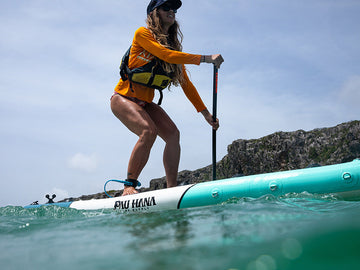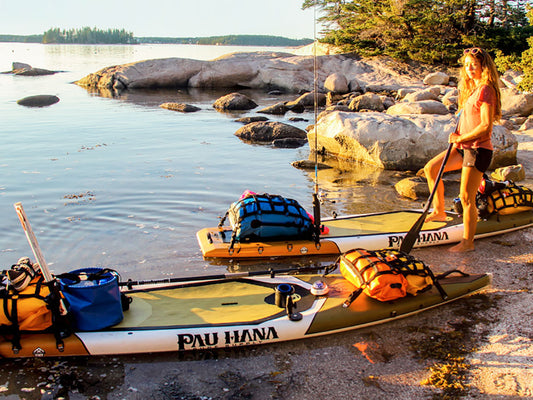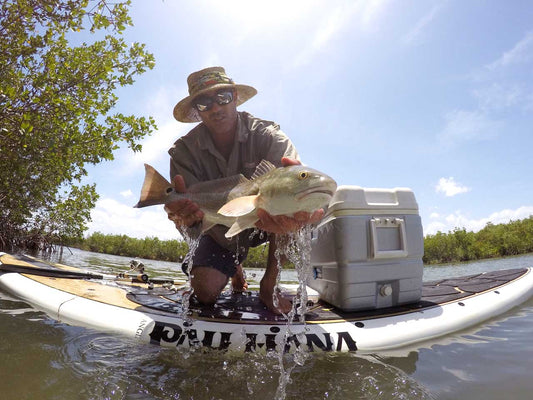Essential Paddleboarding Safety Tips to Stay Safe on the Water
Stand-up paddleboarding (SUP) is an enjoyable, adventurous and versatile water activity, but as with any water sport, safety should always be a priority. Whether you’re a beginner or an experienced paddler, understanding, implementing and adhering to essential safety practices is important. From the right equipment to handling unexpected conditions, this guide will cover everything you need to know to safely navigate the water while paddleboarding.
1. Wear a PFD (Personal Flotation Device)
A Personal Flotation Device (PFD) is one of the most important safety items you can wear while paddleboarding. Even experienced swimmers can benefit from the extra buoyancy, especially in rough, fast-flowing or unpredictable water conditions.
Why You Need a PFD
- Unexpected Falls: Paddle boarders of all skill levels are at risk of falling into the water. A PFD ensures that you stay afloat, regardless of your swimming abilities.
- Legal Requirements: Many regions have laws that require paddle boarders to wear or carry a PFD while on the water, so it’s important to check your local regulations before heading out.
Choosing the Right PFD
As mentioned in the guide on selecting a PFD for paddleboarding, comfort, fit, and buoyancy are important factors. You’ll want to consider whether a foam vest or inflatable belt pack is right for you based on your activity and water conditions.
2. Always Use a Leash
A leash is a vital piece of equipment that keeps you attached to your board in case you fall off. When you’re on the water, especially in windy or choppy conditions, your paddle board can drift away from you quicker than you expect if you’re not connected to it.
Why Leashes Are Essential
- Prevents Separation: In windy conditions or strong currents, being separated from your board can happen quickly and be dangerous. A leash ensures that your board stays within reach, reducing the risk of drifting away.
- Easier Recovery: If you fall off, the leash allows you to retrieve your board and climb back on quickly.
Types of Leashes
- Coiled Leash: Best for flat water paddling, a coiled leash stays on the board and doesn’t drag in the water, which reduces the risk of tangling.
- Straight Leash: More suitable for surfing, this leash drags behind the board, preventing it from snapping back toward you in rough waters.
- Quick Release Leash: Used on moving and white water, a quick release leash allows you to quickly release yourself from being attached to the leash incase of the leash getting entangled on debris in the water.
When using a leash, ensure that it’s attached correctly, usually just above your ankle or calf. It’s also important to match the leash to the environment. For example, avoid using a fixed leash in fast-moving river currents where the leash could get caught.
3. Check Weather and Water Conditions
Before heading out on the water for a paddleboarding session, always check the weather forecast and water conditions. Wind, currents, and waves can quickly change, creating hazards for even the most experienced paddlers.
Wind Conditions
- Strong Winds: High winds can push you off course and make it harder to paddle back to shore. If winds pick up while you’re on the water, consider kneeling on your board to reduce your surface area and maintain balance and control.
- Offshore Winds: Winds blowing away from the shore can be particularly dangerous, as they can carry you farther out to sea or into deeper waters and make it difficult to get back to shore. Avoid paddling in offshore winds if you’re a beginner or unsure of the conditions.
Water Conditions
- Currents and Tides: Be aware of the direction and strength of currents and tides. Strong currents can make it difficult to return to shore or your starting point and strong tides can hinder your ability to move fast on the water.
- Cold Water: If the water is cold, wear appropriate clothing like a wetsuit or drysuit to protect against hypothermia. Even in warm weather, cold water can quickly sap your body heat if you fall in.
Check Local Forecasts
It’s easy to check weather and tide conditions using weather apps or websites. Many apps also offer real-time information about tide patterns, wind speeds, and wave heights. Always err on the side of caution and reschedule your paddleboarding session if conditions look unfavourable.
4. Paddle with a Buddy or Let Someone Know Your Plans
Paddle boarding alone can be peaceful, but it’s always safer to have a friend with you. If you prefer solo paddleboarding, make sure someone knows your plans, including your intended route and estimated return time. A device known as an In-Reach or Spot is a good piece of equipment to own if you are planning to paddle out of signal regularly - These devices work off satellites to allow you to make contact or call for help even without a phone signal.
Why It’s Important
- Emergency Assistance: If something goes wrong, having a friend with you ensures that help is close by or can raise an alarm.
- Accountability: If you’re paddleboarding solo and don’t return when expected, someone will know to seek help. Providing details about your plans, like where you’re paddling and how long you’ll be out, can be a lifesaver in an emergency.
Group Paddling
Paddle boarding with a group or a buddy also makes the activity more sociable and fun. You can explore together, and in the event of an emergency, there’s always someone to help.
5. Be Aware of Boat Traffic and Other Hazards
When paddleboarding, it’s important to consider the area and stay aware of your surroundings. Paddle boards sit lower on the water than many other watercraft, making it harder for other water crafts to spot you. In addition to boat traffic, natural and manmade obstacles can also pose risks.
Dealing with Boat Traffic
- Stay in Designated Paddle Zones: Many areas within highly trafficked waters have designated zones for paddle boarders, kayakers, and other non-motorised watercraft. Stick to these zones to avoid collisions.
- Make Yourself Visible: Wear bright clothing or use reflective gear and water-proof lights if you’ll be paddling in low-light conditions.
- Communicate with Boaters: If you’re in a high-traffic area, make sure to use hand signals to communicate with boaters and avoid crossing directly in front of them.
Avoiding Natural Hazards
- Rocks and Reefs: Be mindful of shallow areas with rocks, reefs, or submerged obstacles that can damage your board or cause injury to your person if you fall in.
- Wildlife: In some areas, you may encounter wildlife such as jellyfish, stingrays, or even sharks. Respect their habitat by maintaining a safe distance.
6. Dress for the Conditions
Your clothing choice can greatly affect your comfort and safety while out paddleboarding. The right gear will protect you from cold water, UV exposure, and sudden changes in the weather.
Cold Weather Paddling
In colder climates or seasons, a wetsuit or drysuit is useful to protect against hypothermia if you fall into the water. A wetsuit provides insulation while allowing some water in, which your body heat warms around you. A drysuit keeps you completely dry by forming a watertight seal.
Warm Weather Paddling
In warm weather, lightweight and breathable clothing is the ideal clothing. Look for moisture-wicking, UV-protective clothing to keep you cool and shielded from the sun. Many paddle boarders wear rash guards or long-sleeve tops with UPF protection to prevent sunburn, along with sunscreen for the unclothed areas.
Footwear
Consider wearing water shoes or neoprene booties to protect your feet in cooler condition and if you’ll be paddling in rocky or uneven areas. Having bare feet is comfortable in warmer conditions, but they leave you vulnerable to cuts and bruises if paddling in shallow and rocky areas.
Sun Protection
Don’t forget sunscreen, sunglasses with a retention strap, and a wide-brimmed hat with chin strap or visor for sun protection. The reflection of the sun off the water can intensify exposure, so reapply sunscreen regularly and wear sun-protective gear.
7. Learn How to Fall Properly
Falling off your paddle board is a natural part of learning and improving. Knowing how to fall safely can prevent injuries and make getting back on your board much easier.
How to Fall Safely
- Fall Away from Your Board: When you feel yourself losing balance, try to fall into the water away from your board to avoid hitting it.
- Hold Onto Your Paddle: If possible, try to hold onto your paddle when you fall. Otherwise, retrieving it might be difficult if the wind or current picks up.
- Use Your Leash: Thanks to your leash, your board won’t drift far. After you fall, swim back to your board and use your arms to pull yourself onto it from the side, rather than trying to mount it from the rear.
Practicing Falls
Especially for beginners, practicing falling and remounting your board in shallow, calm water can build confidence and improve technique. Familiarise yourself with how your board moves and how to get back on it quickly from the water.
8. Be Prepared for Emergencies
Even with good planning, emergencies can happen. Being prepared ensures that you can handle unexpected situations with confidence.
Essential Items to Carry
- Whistle: Attach a whistle to your PFD which you can use to signal for help in case of emergency.
- Waterproof Phone Case: Carry your phone in a waterproof case, so you can call for assistance if needed. Some paddlers also carry a VHF radio, InReach or Spot for communication and SOS.
- First Aid Kit: Bring a small, waterproof first aid kit with basics like bandages, antiseptic, and pain relievers in a dry bag that you can attach to the board.
- Emergency Snacks and Water: For long paddling trips, carry extra water and high-energy snacks to stay hydrated and energised.
Know Basic First Aid
Knowing basic first aid techniques can be valuable if you or someone in your group has a problem. In case of injury, hypothermia, or other emergencies, having first aid knowledge can make a big difference while waiting for professional help. First aid courses are taught all over the country, you can find a local provider online.
The Takeaway
Paddle boarding is a fun and accessible water sport, but it’s important to prioritise safety to make sure every outing is enjoyable and incident-free. By wearing a PFD, using a leash, checking the weather, and staying aware of your surroundings, you can minimise risks and focus on having a great time on the water. Whether you’re a beginner or a seasoned paddler, following these essential SUP safety tips will keep you safe and ready for any adventure.





